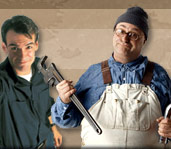How To Use Annuals In Landscaping Your GardenWritten by Paul Curran
Continued from page 1
In no case should they be sown more than 1 inch deep. The seeds of larger plants which have a strong growth, such as sunflowers, can be planted in hills spaced from 2 to 4 feet apart. Often, annuals are planted in rows. This method is used when a cutting garden is being grown. To do this, dig a shallow trench not more than 1 inch deep with a trowel, or your fingers, and then place  seed in seed in trench. trench. Sow more seed than appears necessary, and then trim out after plants appear above ground. Thinning is required, in any event, for a good crop of annuals, if only to insure sufficient room for each plant. Transplanting is a considerable shock in plants appear above ground. Thinning is required, in any event, for a good crop of annuals, if only to insure sufficient room for each plant. Transplanting is a considerable shock in life of a plant, and unless it is carefully done, life of a plant, and unless it is carefully done, plant will die. It is a good idea to expose coldframes and potted seeds to plant will die. It is a good idea to expose coldframes and potted seeds to outside air for a time before transplanting, in order to prevent shock. outside air for a time before transplanting, in order to prevent shock. All soil in soil in frame or pot should be used when transplanting. Transplanting should be done on a cloudy, damp day, if possible. If frame or pot should be used when transplanting. Transplanting should be done on a cloudy, damp day, if possible. If soil is dry, it should be watered before transplanting, and then thoroughly after soil is dry, it should be watered before transplanting, and then thoroughly after plants are in plants are in ground. If ground. If day is sunny, some sort of shade should be provided for day is sunny, some sort of shade should be provided for newly transferred plants. As soon as newly transferred plants. As soon as plants are established, these protective coverings can be removed. plants are established, these protective coverings can be removed.

Paul Curran is CEO of Cuzcom Internet Publishing Group and webmaster at Trees-and-Bushes.com, providing access to their nursery supplier of a range of quality plants, trees, bushes, shrubs, seeds and garden products. Visit their site now to find a great selection of flowers for your garden
| | How To Use Flower Beds In Landscaping Your GardenWritten by Paul Curran
Continued from page 1
Should you use manure, be careful not to let it touch roots of plants. The problems of color should be kept in mind when planning flower borders and beds, so that while there is sufficient contrast in texture and color of roots of plants. The problems of color should be kept in mind when planning flower borders and beds, so that while there is sufficient contrast in texture and color of flowers, there is at flowers, there is at same time an attractive blending. same time an attractive blending. A plan for a bed of annuals, for example, might be designed to stress zinnias, with contrast provided by such softer flowers as chrysanthemum, scabiosa, nasturtium, cosmos and candytuft. Siting of flower bed is important. Ideally, it should be close to flower bed is important. Ideally, it should be close to  house, facing south or south west. house, facing south or south west. Any location that gets good sun, however, will produce well. The border should be located away from trees or shrubs. These plants absorb more than their share of moisture and nutrients from soil and, because of their strength, can overpower soil and, because of their strength, can overpower more delicate flowering plants. more delicate flowering plants. A good background such as a stone wall or a fence adds to beauty of a flower bed or border, and evergreen shrubs make a pleasing backdrop. Edgings need not be restricted, as they so often are, to one color (e.g., beauty of a flower bed or border, and evergreen shrubs make a pleasing backdrop. Edgings need not be restricted, as they so often are, to one color (e.g., white of alyssum). white of alyssum). Coral bells, whose lovely foliage makes a handsome edge, are an all-season flowering plant, and they provide unusual cut flowers. Baby pansies, violas, portulaca, ageratum, dwarf double nasturtium and dwarf marigolds are multi-colored flowers.

Paul Curran is CEO of Cuzcom Internet Publishing Group and webmaster at Trees-and-Bushes.com, providing access to their nursery supplier of a range of quality plants, trees, bushes, shrubs, seeds and garden products. Visit their site now to find a great selection of flowers for your garden
|



